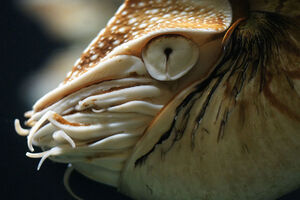Nautilus (nonfiction): Difference between revisions
No edit summary |
No edit summary |
||
| Line 13: | Line 13: | ||
== In the News == | == In the News == | ||
<gallery | <gallery> | ||
</gallery> | </gallery> | ||
== Fiction cross-reference == | == Fiction cross-reference == | ||
* [[Gnomon algorithm]] | |||
* [[Gnomon Chronicles]] | |||
* [[Gnotilus]] | * [[Gnotilus]] | ||
| Line 28: | Line 30: | ||
[[Category:Nonfiction (nonfiction)]] | [[Category:Nonfiction (nonfiction)]] | ||
[[Category:Animals (nonfiction)]] | [[Category:Animals (nonfiction)]] | ||
[[Category:Cephalopods (nonfiction)]] | |||
Latest revision as of 12:23, 23 June 2019
The nautilus (from the Latin form of the original Greek ναυτίλος, 'sailor') is a pelagic marine mollusc of the cephalopod family Nautilidae, the sole extant family of the superfamily Nautilaceae and of its smaller but near equal suborder, Nautilina.
It comprises six living species in two genera, the type of which is the genus Nautilus.
Though it more specifically refers to species Nautilus pompilius, the name chambered nautilus is also used for any species of the Nautilidae.
Nautilidae, both extant and extinct, are characterized by involute or more or less convolute shells that are generally smooth, with compressed or depressed whorl sections, straight to sinuous sutures, and a tubular, generally central siphuncle.
Having survived relatively unchanged for millions of years, nautiluses represent the only living members of the subclass nautiloidea, and are often considered "living fossils."
The name "nautilus" originally referred to the pelagic octopuses of the genus Argonauta, otherwise known as paper nautiluses, as the ancients believed these animals used their two expanded arms as sails.
In the News
Fiction cross-reference
Nonfiction cross-reference
External links:
- Nautilus @ Wikipedia
